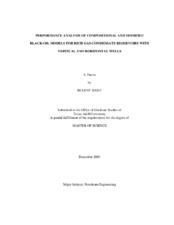| dc.description.abstract | It has been known that volatile oil and gas condensate reservoirs cannot be modeled accurately with conventional black-oil models. One variation to the black-oil approach is the modified black-oil (MBO) model that allows the use of a simple, and less expensive computational algorithm than a fully compositional model that can result in significant timesaving in full field studies. The MBO model was tested against the fully compositional model and performances of both models were compared using various production and injection scenarios for a rich gas condensate reservoir. The software used to perform the compositional and MBO runs were Eclipse 300 and Eclipse 100 versions 2002A. The effects of black-oil PVT table generation methods, uniform composition and compositional gradient with depth, initialization methods, location of the completions, production and injection rates, kv/kh ratios on the performance of the MBO model were investigated. Vertical wells and horizontal wells with different drain hole lengths were used. Contrary to the common belief that oil-gas ratio versus depth initialization gives better representation of original fluids in place, initializations with saturation pressure versus depth gave closer original fluids in place considering the true initial fluids in place are given by the fully compositional model initialized with compositional gradient. Compared to the compositional model, results showed that initially there was a discrepancy in saturation pressures with depth in the MBO model whether it was initialized with solution gas-oil ratio (GOR) and oil-gas ratio (OGR) or dew point pressure versus depth tables. In the MBO model this discrepancy resulted in earlier condensation and lower oil production rates than compositional model at the beginning of the simulation. Unrealistic vaporization in the MBO model was encountered in both natural depletion and cycling cases. Oil saturation profiles illustrated the differences in condensate saturation distribution for the near wellbore area and the entire reservoir even though the production performance of the models was in good agreement. The MBO model representation of compositional phenomena for a gas condensate reservoir proved to be successful in the following cases: full pressure maintenance, reduced vertical communication, vertical well with upper completions, and producer set as a horizontal well. | en |


